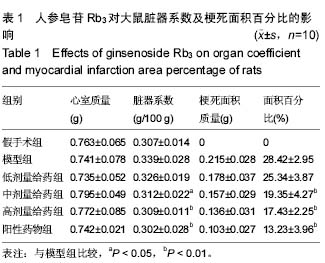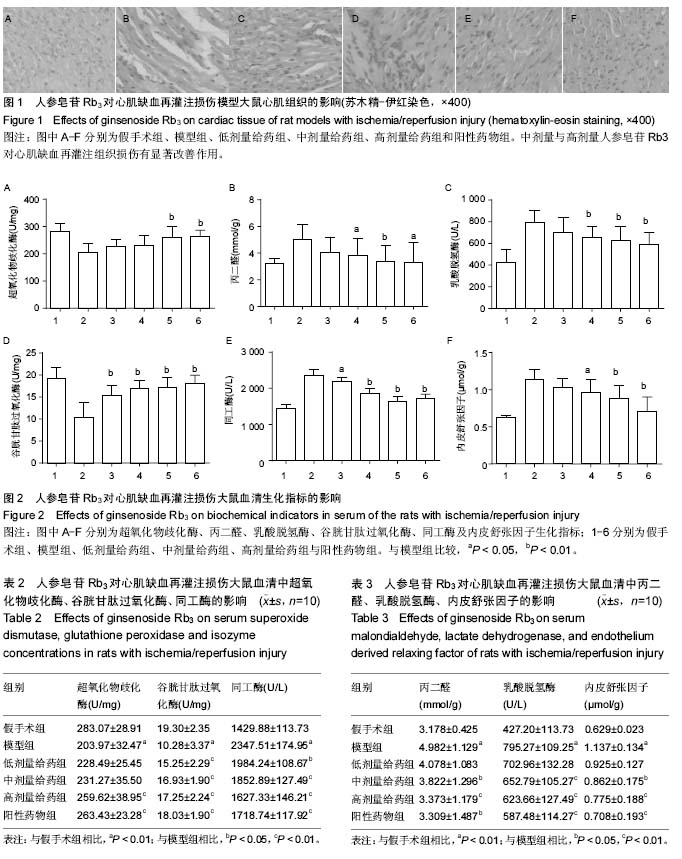中国组织工程研究 ›› 2016, Vol. 20 ›› Issue (49): 7320-7326.doi: 10.3969/j.issn.2095-4344.2016.49.004
• 心脏及血管损伤动物模型 Animal models of heart and vascular damage • 上一篇 下一篇
人参皂苷Rb3对心肌缺血再灌注损伤模型大鼠的保护
吴惠珍1,贾庆忠2
- 1河北省人民医院药学部,河北省石家庄市 050001;2河北医科大学药理教研室,河北省石家庄市 050001
Protective effects of ginsenoside Rb3 on a rat model of ischemia/reperfusion injury
Wu Hui-zhen1, Jia Qing-zhong2
- 1Department of Pharmacy, Hebei Provincial People’s Hospital, Shijiazhuang 050001, Hebei Province, China; 2Department of Pharmacology, Hebei Medical University, Shijiazhuang 050001, Hebei Province, China
摘要:
文章快速阅读:
.jpg) 文题释义:
心肌缺血再灌注损伤:是常见心血管疾病,指心脏血流灌注减少,心脏供氧减少,心肌能量代谢失常,无法支持心脏正常工作的一种病理状态,常见原因是冠状动脉粥样硬化。再灌注是指组织或器官缺血后恢复供血的过程,此过程往往会加重组织损伤。心肌缺血再灌注损伤已成为冠状动脉搭桥手术、介入治疗及冠状动脉溶栓治疗的常见并发症,目前临床上治疗此病药物主要有硝酸酯类、他汀类、钙离子拮抗剂等,近年来中药也成为心肌缺血再灌注损伤治疗的热点。
人参皂苷:为人参的主要有效成分,对中枢神经系统、循环系统、代谢系统、造血系统等具有丰富的药理药效作用。人参皂苷种类繁多,含量约为4%,一般可分为人参二醇类皂苷、原人参三醇类及齐墩果酸类3种。其中原人参二醇类皂苷约有20种,主要有Rb1、Rb2、Rb3、Rc、Rd等,约占人参总皂苷的55%;而原人参三醇类在约有10种,主要有Re、Rg1、Rg2等,约占人参总皂苷的40%;齐墩果酸。
文题释义:
心肌缺血再灌注损伤:是常见心血管疾病,指心脏血流灌注减少,心脏供氧减少,心肌能量代谢失常,无法支持心脏正常工作的一种病理状态,常见原因是冠状动脉粥样硬化。再灌注是指组织或器官缺血后恢复供血的过程,此过程往往会加重组织损伤。心肌缺血再灌注损伤已成为冠状动脉搭桥手术、介入治疗及冠状动脉溶栓治疗的常见并发症,目前临床上治疗此病药物主要有硝酸酯类、他汀类、钙离子拮抗剂等,近年来中药也成为心肌缺血再灌注损伤治疗的热点。
人参皂苷:为人参的主要有效成分,对中枢神经系统、循环系统、代谢系统、造血系统等具有丰富的药理药效作用。人参皂苷种类繁多,含量约为4%,一般可分为人参二醇类皂苷、原人参三醇类及齐墩果酸类3种。其中原人参二醇类皂苷约有20种,主要有Rb1、Rb2、Rb3、Rc、Rd等,约占人参总皂苷的55%;而原人参三醇类在约有10种,主要有Re、Rg1、Rg2等,约占人参总皂苷的40%;齐墩果酸。
.jpg) 文题释义:
心肌缺血再灌注损伤:是常见心血管疾病,指心脏血流灌注减少,心脏供氧减少,心肌能量代谢失常,无法支持心脏正常工作的一种病理状态,常见原因是冠状动脉粥样硬化。再灌注是指组织或器官缺血后恢复供血的过程,此过程往往会加重组织损伤。心肌缺血再灌注损伤已成为冠状动脉搭桥手术、介入治疗及冠状动脉溶栓治疗的常见并发症,目前临床上治疗此病药物主要有硝酸酯类、他汀类、钙离子拮抗剂等,近年来中药也成为心肌缺血再灌注损伤治疗的热点。
人参皂苷:为人参的主要有效成分,对中枢神经系统、循环系统、代谢系统、造血系统等具有丰富的药理药效作用。人参皂苷种类繁多,含量约为4%,一般可分为人参二醇类皂苷、原人参三醇类及齐墩果酸类3种。其中原人参二醇类皂苷约有20种,主要有Rb1、Rb2、Rb3、Rc、Rd等,约占人参总皂苷的55%;而原人参三醇类在约有10种,主要有Re、Rg1、Rg2等,约占人参总皂苷的40%;齐墩果酸。
文题释义:
心肌缺血再灌注损伤:是常见心血管疾病,指心脏血流灌注减少,心脏供氧减少,心肌能量代谢失常,无法支持心脏正常工作的一种病理状态,常见原因是冠状动脉粥样硬化。再灌注是指组织或器官缺血后恢复供血的过程,此过程往往会加重组织损伤。心肌缺血再灌注损伤已成为冠状动脉搭桥手术、介入治疗及冠状动脉溶栓治疗的常见并发症,目前临床上治疗此病药物主要有硝酸酯类、他汀类、钙离子拮抗剂等,近年来中药也成为心肌缺血再灌注损伤治疗的热点。
人参皂苷:为人参的主要有效成分,对中枢神经系统、循环系统、代谢系统、造血系统等具有丰富的药理药效作用。人参皂苷种类繁多,含量约为4%,一般可分为人参二醇类皂苷、原人参三醇类及齐墩果酸类3种。其中原人参二醇类皂苷约有20种,主要有Rb1、Rb2、Rb3、Rc、Rd等,约占人参总皂苷的55%;而原人参三醇类在约有10种,主要有Re、Rg1、Rg2等,约占人参总皂苷的40%;齐墩果酸。摘要
背景:人参皂苷Rb3具有多种生理活性,主要集中体现在心血管方面。
目的:观察人参皂苷Rb3对大鼠心肌缺血再灌注损伤的保护作用。
方法:将120只SD大鼠随机分6组,每组20只,模型组、假手术组灌胃给予生理盐水2 mL/(kg•d),连续2 d;阳性药物组灌胃给予地尔硫卓2 mL/(kg•d),连续2 d;低剂量给药组、中剂量给药组、高剂量给药组分别灌胃给予人参皂苷Rb3 10,20,30 mg/(kg•d),连续2 d。给药2 d后,假手术组只开胸,不做任何处理;其余5组结扎左侧冠状动脉前降支,建立心肌缺血再灌注损伤模型,48 h后,观察大鼠心肌组织病理切片,计算脏器系数与心肌梗死面积百分比,测定血清中同工酶、丙二醛、乳酸脱氢酶、内皮舒张因子、超氧化物歧化酶、谷胱甘肽过氧化酶等生化指标的水平。
结果与结论:①病理切片:中剂量与高剂量人参皂苷Rb3对心肌缺血再灌注组织损伤有显著改善作用;②脏器系数与心肌梗死面积百分比:与模型组比较,中剂量与高剂量人参皂苷Rb3能显著降低大鼠脏器系数及心肌梗死面积百分比(P < 0.05,P < 0.01);③血清指标:与模型组比较,人参皂苷Rb3呈剂量依赖性降低同工酶、丙二醛、乳酸脱氢酶、内皮舒张因子水平,呈剂量依赖性升高谷胱甘肽过氧化酶、超氧化物歧化酶水平;④结果表明:人参皂苷Rb3对大鼠心肌缺血再灌注损伤有保护作用,其作用机制可能与抗细胞过脂质化、抗自由基、抗炎症反应及影响心肌酶参与体内能量代谢的过程有关。
中国组织工程研究杂志出版内容重点:肾移植;肝移植;移植;心脏移植;组织移植;皮肤移植;皮瓣移植;血管移植;器官移植;组织工程
ORCID: 0000-0002-7776-1049(吴惠珍)
中图分类号:


.jpg) 文题释义:
心肌缺血再灌注损伤:是常见心血管疾病,指心脏血流灌注减少,心脏供氧减少,心肌能量代谢失常,无法支持心脏正常工作的一种病理状态,常见原因是冠状动脉粥样硬化。再灌注是指组织或器官缺血后恢复供血的过程,此过程往往会加重组织损伤。心肌缺血再灌注损伤已成为冠状动脉搭桥手术、介入治疗及冠状动脉溶栓治疗的常见并发症,目前临床上治疗此病药物主要有硝酸酯类、他汀类、钙离子拮抗剂等,近年来中药也成为心肌缺血再灌注损伤治疗的热点。
人参皂苷:为人参的主要有效成分,对中枢神经系统、循环系统、代谢系统、造血系统等具有丰富的药理药效作用。人参皂苷种类繁多,含量约为4%,一般可分为人参二醇类皂苷、原人参三醇类及齐墩果酸类3种。其中原人参二醇类皂苷约有20种,主要有Rb1、Rb2、Rb3、Rc、Rd等,约占人参总皂苷的55%;而原人参三醇类在约有10种,主要有Re、Rg1、Rg2等,约占人参总皂苷的40%;齐墩果酸。
文题释义:
心肌缺血再灌注损伤:是常见心血管疾病,指心脏血流灌注减少,心脏供氧减少,心肌能量代谢失常,无法支持心脏正常工作的一种病理状态,常见原因是冠状动脉粥样硬化。再灌注是指组织或器官缺血后恢复供血的过程,此过程往往会加重组织损伤。心肌缺血再灌注损伤已成为冠状动脉搭桥手术、介入治疗及冠状动脉溶栓治疗的常见并发症,目前临床上治疗此病药物主要有硝酸酯类、他汀类、钙离子拮抗剂等,近年来中药也成为心肌缺血再灌注损伤治疗的热点。
人参皂苷:为人参的主要有效成分,对中枢神经系统、循环系统、代谢系统、造血系统等具有丰富的药理药效作用。人参皂苷种类繁多,含量约为4%,一般可分为人参二醇类皂苷、原人参三醇类及齐墩果酸类3种。其中原人参二醇类皂苷约有20种,主要有Rb1、Rb2、Rb3、Rc、Rd等,约占人参总皂苷的55%;而原人参三醇类在约有10种,主要有Re、Rg1、Rg2等,约占人参总皂苷的40%;齐墩果酸。